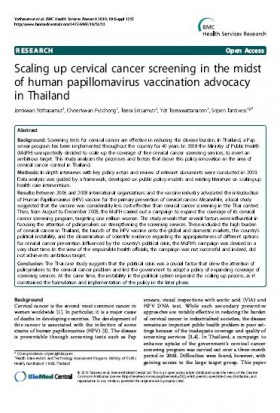This website uses cookies so that we can provide you with the best user experience possible. Cookie information is stored in your browser and performs functions such as recognising you when you return to our website and helping our team to understand which sections of the website you find most interesting and useful.
Scaling up cervical cancer screening in the midst of human papillomavirus vaccination advocacy in Thailand.(2010)

Details
Scaling up cervical cancer screening in the midst of human papillomavirus vaccination advocacy in Thailand
Jomkwan Yothasamut1, Choenkwan Putchong1, Teera Sirisamutr1, Yot Teerawattananon1, Sripen Tantivess1,2*
1Health Intervention and Technology Assessment Program, Ministry of Public Health, Thailand.
2International Health Policy Program, Ministry of Public Health, Thailand.
Backgroud
Screening tests for cervical cancer are effective in reducing the disease burden. In Thailand, a Pap smear program has been implemented throughout the country for 40 years. In 2008 the Ministry of Public Health (MoPH) unexpectedly decided to scale up the coverage of free cervical cancer screening services, to meet an ambitious target. This study analyzes the processes and factors that drove this policy innovation in the area of cervical cancer control in Thailand.
Methods
In-depth interviews with key policy actors and review of relevant documents were conducted in 2009. Data analysis was guided by a framework, developed on public policy models and existing literature on scaling-up health care interventions.
Results
Between 2006 and 2008 international organizations and the vaccine industry advocated the introduction of Human Papillomavirus (HPV) vaccine for the primary prevention of cervical cancer. Meanwhile, a local study suggested that the vaccine was considerably less cost-effective than cervical cancer screening in the Thai context. Then, from August to December 2008, the MoPH carried out a campaign to expand the coverage of its cervical cancer screening program, targeting one million women. The study reveals that several factors were influential in focusing the attention of policymakers on strengthening the screening services. These included the high burden of cervical cancer in Thailand, the launch of the HPV vaccine onto the global and domestic markets, the country’s political instability, and the dissemination of scientific evidence regarding the appropriateness of different options for cervical cancer prevention. Influenced by the country’s political crisis, the MoPH’s campaign was devised in a very short time. In the view of the responsible health officials, the campaign was not successful and indeed, did not achieve its ambitious target.
Conclusion
The Thai case study suggests that the political crisis was a crucial factor that drew the attention of policymakers to the cervical cancer problem and led the government to adopt a policy of expanding coverage of screening services. At the same time, the instability in the political system impeded the scaling up process, as it constrained the formulation and implementation of the policy in the later phase




